药理学简史英文
- 格式:ppt
- 大小:3.74 MB
- 文档页数:38

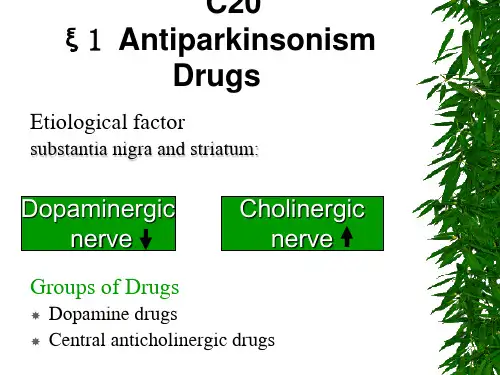
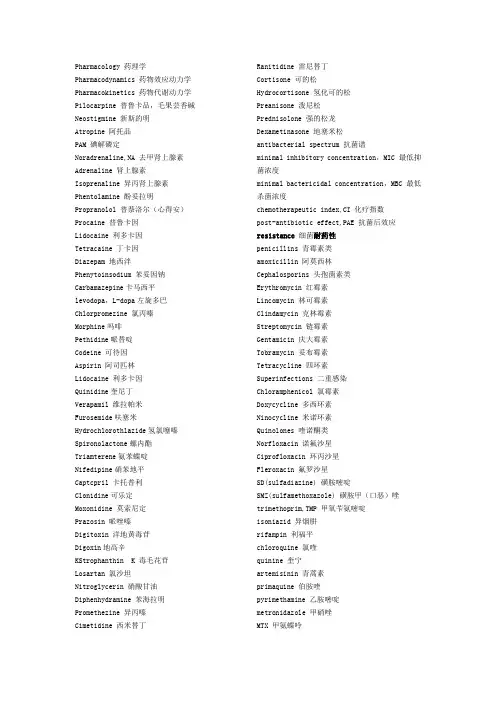
Pharmacology 药理学Pharmacodynamics 药物效应动力学Pharmacokinetics 药物代谢动力学Pilocarpine 普鲁卡品,毛果芸香碱Neostigmine 新斯的明Atropine 阿托品PAM 碘解磷定Noradrenaline,NA 去甲肾上腺素Adrenaline 肾上腺素Isoprenaline 异丙肾上腺素Phentolamine 酚妥拉明Propranolol 普萘洛尔(心得安)Procaine 普鲁卡因Lidocaine 利多卡因Tetracaine 丁卡因Diazepam 地西泮Phenytoinsodium 苯妥因钠Carbamazepine卡马西平levodopa,L-dopa左旋多巴Chlorpromezine 氯丙嗪Morphine吗啡Pethidine哌替啶Codeine 可待因Aspirin 阿司匹林Lidocaine 利多卡因Quinidine奎尼丁Verapamil 维拉帕米Furosemide呋塞米Hydrochlorothlazide氢氯噻嗪Spironolactone螺内酯Triamterene氨苯蝶啶Nifedipine硝苯地平Captcpril 卡托普利Clonidine可乐定Moxonidine 莫索尼定Prazosin 哌唑嗪Digitoxin 洋地黄毒苷Digoxin地高辛KStrophanthin K 毒毛花苷Losartan 氯沙坦Nitroglycerin 硝酸甘油Diphenhydramine 苯海拉明Promethezine 异丙嗪Cimetidine 西米替丁Ranitidine 雷尼替丁Cortisone 可的松Hydrocortisone 氢化可的松Preanisone 泼尼松Prednisolone 强的松龙Dexametinasone 地塞米松antibacterial spectrum 抗菌谱minimal inhibitory concentration,MIC 最低抑菌浓度minimal bactericidal concentration,MBC 最低杀菌浓度chemotherapeutic index,CI 化疗指数post-antibiotic effect,PAE 抗菌后效应resistance 细菌耐药性penicillins 青霉素类amoxicillin 阿莫西林Cephalosporins 头孢菌素类Erythromycin 红霉素Lincomycin 林可霉素Clindamycin 克林霉素Streptomycin 链霉素Gentamicin 庆大霉素Tobramycin 妥布霉素Tetracycline 四环素Superinfections 二重感染Chloramphenicol 氯霉素Doxycycline 多西环素Ninocycline 米诺环素Quinolones 喹诺酮类Norfloxacin 诺氟沙星Ciprofloxacin 环丙沙星Fleroxacin 氟罗沙星SD(sulfadiazine) 磺胺嘧啶SMZ(sulfamethoxazole) 磺胺甲(口恶)唑trimethoprim,TMP 甲氧苄氨嘧啶isoniazid 异烟肼rifampin 利福平chloroquine 氯喹quinine 奎宁artemisinin 青蒿素primaquine 伯胺喹pyrimethamine 乙胺嘧啶metronidazole 甲硝唑MTX 甲氨蝶呤。
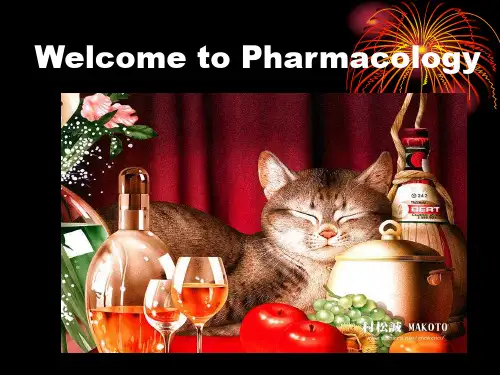
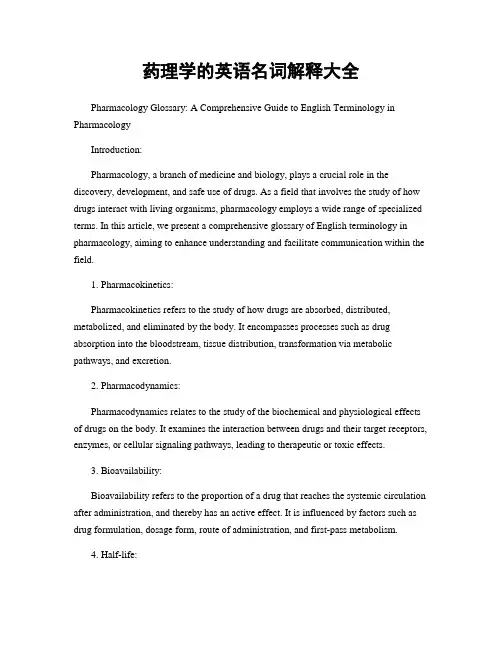
药理学的英语名词解释大全Pharmacology Glossary: A Comprehensive Guide to English Terminology in PharmacologyIntroduction:Pharmacology, a branch of medicine and biology, plays a crucial role in the discovery, development, and safe use of drugs. As a field that involves the study of how drugs interact with living organisms, pharmacology employs a wide range of specialized terms. In this article, we present a comprehensive glossary of English terminology in pharmacology, aiming to enhance understanding and facilitate communication within the field.1. Pharmacokinetics:Pharmacokinetics refers to the study of how drugs are absorbed, distributed, metabolized, and eliminated by the body. It encompasses processes such as drug absorption into the bloodstream, tissue distribution, transformation via metabolic pathways, and excretion.2. Pharmacodynamics:Pharmacodynamics relates to the study of the biochemical and physiological effects of drugs on the body. It examines the interaction between drugs and their target receptors, enzymes, or cellular signaling pathways, leading to therapeutic or toxic effects.3. Bioavailability:Bioavailability refers to the proportion of a drug that reaches the systemic circulation after administration, and thereby has an active effect. It is influenced by factors such as drug formulation, dosage form, route of administration, and first-pass metabolism.4. Half-life:The half-life of a drug is the time taken for its concentration in the body to decrease by half. It is an important parameter to determine the duration of action and dosing frequency of drugs. Drugs with a shorter half-life may require more frequent dosing to maintain therapeutic levels.5. Toxicity:Toxicity refers to the potential harmful effects of drugs on the body. It can range from mild and reversible side effects to severe organ damage or life-threatening conditions. Understanding the toxicity profile of drugs is essential for evaluating their safety and establishing appropriate dosage regimens.6. Efficacy:Efficacy describes the extent to which a drug produces the desired therapeutic effect. It represents the maximum achievable effect of a drug and is typically evaluated through clinical trials. Efficacy is distinct from potency, which refers to the dose required to produce a given effect.7. Drug interactions:Drug interactions occur when the effects of one drug are altered by the simultaneous presence of another drug, food, or substance. Interactions can result in enhanced or diminished therapeutic effects, adverse reactions, or changes in drug metabolism. It is crucial to assess and manage potential interactions during drug therapy.8. Pharmacogenetics:Pharmacogenetics investigates the influence of genetic variations on an individual's response to drugs. By studying genetic markers, researchers can better understand inter-individual differences in drug efficacy and toxicity. This field aims to guide personalized medicine by tailoring drug selection and dosage to an individual's genetic profile.9. Placebo effect:The placebo effect refers to the phenomenon where a patient experiences a perceived therapeutic benefit from an inactive substance or treatment. This effect underscores the importance of controlling for placebo responses in clinical trials when evaluating drug efficacy.10. Adverse drug reactions:Adverse drug reactions are undesired and harmful effects caused by drug administration. They can range from mild allergic reactions to severe conditions, including anaphylaxis or organ failure. Pharmacovigilance aims to identify, prevent, and manage adverse drug reactions to ensure patient safety.Conclusion:This comprehensive glossary provides a glimpse into the intricacies of pharmacology and its associated English terminology. By familiarizing themselves with these terms, healthcare professionals and researchers can enhance their communication and understanding of pharmacological concepts. As pharmacology continues to evolve, staying updated with the field's terminology becomes essential for driving advancements in drug discovery, development, and therapy.。
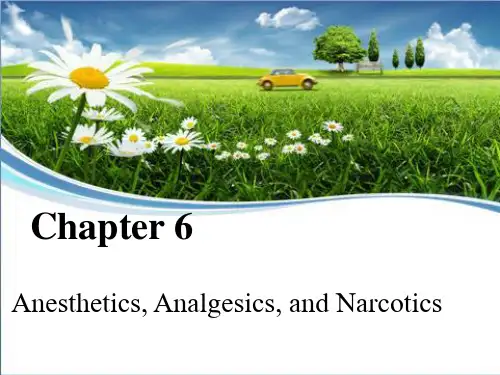
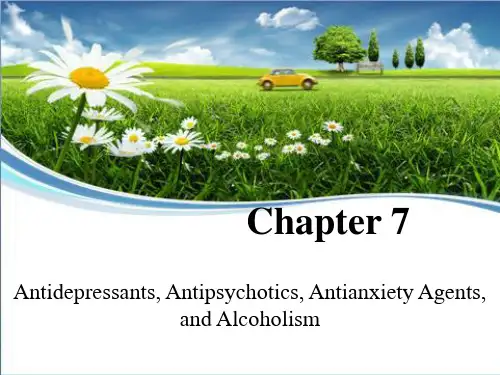
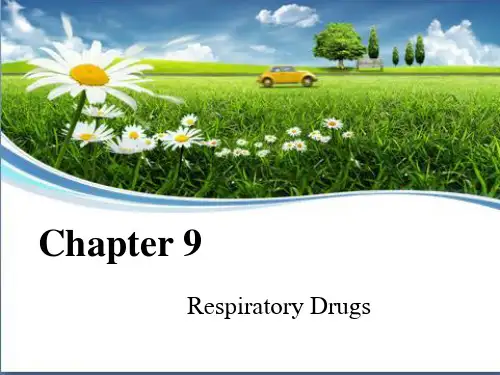
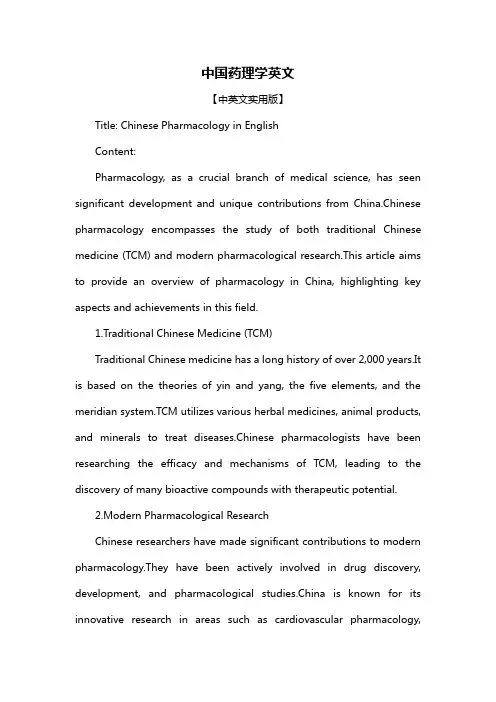
中国药理学英文【中英文实用版】Title: Chinese Pharmacology in EnglishContent:Pharmacology, as a crucial branch of medical science, has seen significant development and unique contributions from China.Chinese pharmacology encompasses the study of both traditional Chinese medicine (TCM) and modern pharmacological research.This article aims to provide an overview of pharmacology in China, highlighting key aspects and achievements in this field.1.Traditional Chinese Medicine (TCM)Traditional Chinese medicine has a long history of over 2,000 years.It is based on the theories of yin and yang, the five elements, and the meridian system.TCM utilizes various herbal medicines, animal products, and minerals to treat diseases.Chinese pharmacologists have been researching the efficacy and mechanisms of TCM, leading to the discovery of many bioactive compounds with therapeutic potential.2.Modern Pharmacological ResearchChinese researchers have made significant contributions to modern pharmacology.They have been actively involved in drug discovery, development, and pharmacological studies.China is known for its innovative research in areas such as cardiovascular pharmacology,neuropharmacology, oncology, and infectious diseases.3.Herbal Medicine and Natural ProductsHerbal medicine plays a vital role in Chinese pharmacology.Many traditional herbal formulas have been scientifically evaluated for their pharmacological activities.Chinese researchers have identified numerous bioactive compounds from medicinal plants, which are being used to develop new drugs and healthcare products.These natural products often possess fewer side effects compared to synthetic drugs.4.Regulatory Affairs and Drug ApprovalChina"s regulatory system for drug approval has been continuously improving.The China Food and Drug Administration (CFDA) ensures the safety, efficacy, and quality of drugs.Chinese pharmacologists actively participate in the regulatory process, providing scientific data to support drug registration and approval.5.International CollaborationChinese pharmacologists collaborate extensively with researchers worldwide.This exchange of knowledge and expertise has led to joint research projects, publications, and the advancement of pharmacological science.China"s active participation in international conferences and research initiatives has enhanced its reputation in the field of pharmacology.Conclusion:Chinese pharmacology has made significant strides in both traditional and modern aspects of the discipline.The integration of TCM and modern pharmacological research has provided unique insights into the development of new drugs and treatment strategies.With ongoing research and international collaboration, China continues to contribute to the global pharmacological community.标题:中国药理学英文内容:药理学作为医学科学的重要分支,在中国得到了显著的发展和独特的贡献。
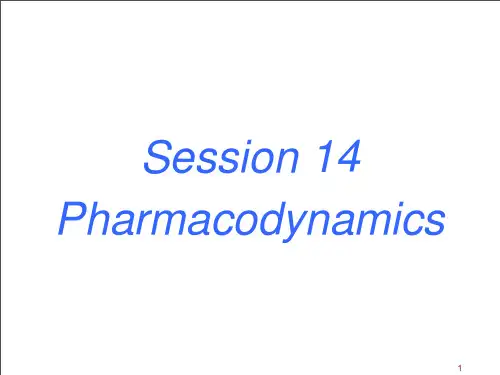
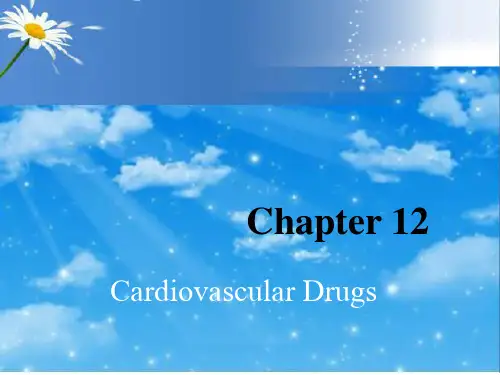
1.What are therapeutic effect and adverse drug reaction? What are the classification and definition of different types of adverse drug reaction?Adverse drug reaction:①Side reaction Side reaction occurs in therapeutic doses and usually in mild appearance; results mostly from drugs that lack specificity. e.g. Insomnia is the common CNS adverse effect of ephedrine(麻黄碱)②Toxic reaction :Toxic reaction implies a direct action of the drug, often at high dose, damaging cells.③Residual effect:although the drug concentration in plasma has decreased under the thresholds concentration,the drug may still make action④Withdrawal reaction :Sudden discontinuation of clonidine may cause rebound reaction,worsen the condition of patients⑤Allergic reaction:Allergic reaction is an immune response. Allergic reaction to drugs are the resultant of the interaction of drug or metabolite (or a nondrug element in the formulation) with patient and disease, and subsequent re-exposure.⑥Idiosyncratic reaction:Idiosyncrasy is defined as a genetically determined abnormal reactivity to a chemical2. What are the definition and characteristics of zero-order elimination kinetics? How to calculate the t1/2 of a drug with zero-order elimination kinetics?What are the definition and characteristics of first-order elimination kinetics? How to calculate the t1/2 of a drug withfirst-order elimination kinetics?zero-order elimination kineticsDefinition:Zero-order kinetics describes a decrease in drug levels in the body that is independent of the plasma concentration.Characteristics:①The rate of elimination is constant (i.e constant amount elimination per unit time is independent of drug concentration).②When the plasma concentration is plotted against time, the decrease is a straight line.③A few drugs are eliminated as zero-order kinetics.t½=0.5 C0/KFirst-order elimination kinetics:Definition: the rate of elimination is proportional to the drug concentration in the plasma Characteristics:①Elimination rate is not constant, when drug concentration is high, rate of disappearance is high.②The plot of drug plasma concentration against time is curvilinear. However, it turns out that the logarithm of the plasma concentration plotted against time is linear.③the half-life is constant that do not change with concentration.t1/2=0.693/k e3. Which drugs can be used to treat glaucoma in autonomic drugs?•The eye:–Glaucoma:•Mechanism:(1) reduce intraocular pressure by causing contraction of the ciliary body→facilitate outflow of aqueous humor(2) diminishing the rate of its secretion.•Drugs: muscarinic stimulants (pilocarpine)cholinesterase inhibitors (physostigmine)Timolol—β-receptor blocker4. What are the pharmacological effects and therapeutic application of atropine?Mechanism of atropine action•Tissue’s sensitivity:salivary, bronchial, and sweat glands > smooth muscle autonomic effectors, heart > gastric parietal cells•In most tissues, it is more effective in blocking exogenously administered cholinoceptor agonists than endogenously released Ach.Organ system effects of atropine•Central nervous systemTherapeutic doses: minimal stimulant effects•Eye–Block the pupillary constrictor muscle, results in unopposed sympathetic dilator activity——mydriasis–Weakening of contraction of the ciliary muscle——cycloplegia–Loss of the ability to accommodate: cannot focus for near vision–Reduction of lacrimal secretion——dry or “sandy” eyes•Cardiovascular system–Lower doses: bradycardia→tachycardia–Moderate to high doses: a blockade of vagala relative tachycardia–Toxic doses: intraventricular conduction block, cutaneous vasodilation–The net effects: tachycardia, and little effect on blood pressure •Respiratory system–Bronchodilation–Reduction of secretion–Notice:The effect is much more dramatic in patients with airway disease.The effect of unselective antimuscarinic drugs in treating COPD is limited.•Gastrointestinal tract–Decrease salivary secretion——dry mouth–Large doses of atropine reduce the volume and amount of acid, pepsin, and mucin of gastric secretion–Relax the walls of the viscera, and both tone and propulsive movements are diminished——gastric emptying time is prolonged, intestinal transit time islengthened——intestinal “paralysis”•Genitourinary tract–Relax the smooth muscle of ureters and bladder wall ——voiding is slowed–No significant effect on the uterus•Sweat glands–Suppress the thermoregulatory sweating–Notice:In infants and children even ordinary doses may cause “atropine fever”•Therapeutic applications•Central nervous system disorders:–Parkinson’s disease•Parkinsonian tremor and rigidity seem to result from:cholinergic activity↑dopaminergic activity↓•The tremor is reduced by centrally acting antimuscarinic drugs –Motion sickness•Certain vestibular disorders ——scopolamine or antihistaminic agents •Ophthalmologic disorders:–Accurate measurement of refractive error in uncooperative patients requires ciliary paralysis.–Ophthalmoscopic examination of the retina (shorter-acting drugs)–Prevent adhesion formation in uveitis and iritis (longer-lasting drugs)–Notice:Never be used for mydriasis for funduscopic examination unless cycloplegia or prolonged action is required, usually replaced by α-adrenoceptor stimulant drugs •Respiratory disorders–Routine preoperative medication when anesthetics such as ether were used, in order to reduce the accumulation of secretions in the trachea and the possibilityof laryngospasm.•Gastrointestinal disorders:–Peptic ulcer——only selective M1 blockers, such as pirenzepine–Common traveler’s diarrhea–Other mild or self-limited conditions of hypermotility (atropine) •Urinary disorders–Urinary urgency caused by minor inflammatory bladder disorders•Only symptomatic relief•Specific antimicrobial therapy is essential in bacterial cystitis–Urolithiasis to relieve the ureteral smooth muscle spasm caused by passage of the stone•Cholinergic poisoning(1) Antimuscarinic therapy: atropine•Large doses•Use earlier•Repeat many times•Only reverse the muscarinic effects(2) Cholinesterase regenerator compounds:pralidoxime (PAM)•Hydroly ze the phosphorylated enzyme if the complex has not “aged”.•Regenerate the AchE associated with skeletal muscle neuromuscular junctions.•Ineffective in reversing the central effects•Only administered by intravenous infusion(3) Pretreatment with reversible inhibitorsof the enzyme to prevent binding of theirreversible organophosphate inhibitor(pyridostigmine, physostigmine)•Mushroom poisoning–Rapid-onset type:•Signs of muscarinic excess•Parenteral atropine–Delayed-onset type:•Hepatic and renal cellular injury•Atropine is of no use•Other applications–HyperhidrosisOccurs in Hyoscyamus niger, or henbaneBe rapidly and fully distributed into the central nervous systemMarked central effects—— drowsiness, amnesia–Toxic doses: excitement, agitation, hallucinations, coma–Be effective in preventing or reversing vestibular disturbances Anisodamine 6-542 more selective for vessels6. Describe the differences between epinephrine and ephedrine.肾上腺素和麻黄碱的一般药理作用相似。
The word “pharmacology” derives from the Greek word for drug, pharmakon. It is the branch of medicine and biology concerned with the study of the actions, uses, mechanisms, and adverse effects of drugs. More specifically, it is the study of the interactions that occur between a living organism and chemicals that affect normal or abnormal biochemical function. If substances have medicinal properties, they are considered pharmaceuticals. The field of pharmacology encompasses drug composition and properties, interactions, toxicology, therapy, and medical applications and anti-pathogenic capabilities.“Pharmacology”一词来源于希腊语药物pharmakon,它是医学与生物学的分支,涉及研究药物的作用、用途、机制及不良反应。
更具体地说,它是研究发生在活体和化学物质间的相互作用,该作用可影响正常或异常的生化功能。
如果物质有药用价值,则认为它们是药物。
药理学包括药物的成分和性质、相互作用、毒理学、治疗作用、临床应用及抗致病能力。
The two main areas of pharmacology are pharmacodynamics and pharmacokinetics. The former studies the effects of the drugs on biological systems, and the latter studies the effects of biological systems on the drugs. In broad terms, pharmacodynamics discusses the interactions of chemicals with biological receptors, and pharmacokinetics discusses the absorption, distribution, metabolism, and excretion of chemicals from the biological systems.药理学的两个主要方面是药效学和药代动力学。